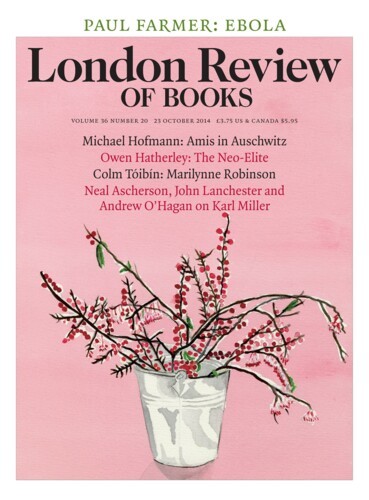Walking from the Bastille to the rue Saint-Antoine in Paris a few weeks ago, I was thinking how swiftly the last few decades have taken their revenge on the past. The spectacle that overshadows all else in France today is the collapse of the political civilisation whose foundations were laid in 1789. Radical France – its intelligentsia, its political parties, its cinema and its press – has been neo-liberalised. Jean-Marie Colombani’s notorious post 9/11 editorial in Le Monde – ‘Nous sommes tous Américains’ – turned out to be a prophecy. Is it possible that the country’s historical memory will soon be erased and the events of the memorable years – 1789, 1793, 1815, 1830, 1848, 1871, 1936, 1968 – misrepresented or forgotten?
The new liberals, the historians François Furet and Pierre Nora, the politicians Jospin and Hollande, prepared the ground well for the French right. Manuel Valls, currently the Socialist prime minister, declares his admiration for Tony Blair while competing with the Front National’s Marine Le Pen to humiliate minorities. There is more than a whiff of Vichy in the air, with Muslims and Roma taking the place of Jews.
How many passers-by are aware that the monument in the centre of the place de la Bastille commemorates the martyrs of the July Revolution of 1830? The king had insisted on pushing through unpopular ordnances, dissolving the recently elected Chamber of Deputies, taking the vote away from the middle class and suspending press freedom. Up went the barricades. Charles X, like previous royal asylum seekers, fled to London, leaving behind the corpses of more than two hundred citizens, killed in the fight for press freedom.
Today the French press is in a bad way. Le Figaro is not as biased as the Telegraph, but it’s getting there. Le Monde and Libération are corporatised and in decline. It’s true that Le Monde diplomatique still appears every month, but though dependable on statistics and global politics, it’s too worthy and too dull to have any serious impact on national politics.
The challenge to the press has come from a website called Mediapart, launched in 2008 to expose the corruptions embedded in the Fifth Republic’s institutions and political parties. It was the idea of Edwy Plenel, a former editor of Le Monde, and three senior colleagues – François Bonnet (the editor), Gérard Desportes and Laurent Mauduit – who between them had vast experience and, more important, good contact lists. In Fabrice Arfy they have a meticulous and thorough investigator reminiscent of the young Paul Foot of the old Private Eye.
Mediapart is run on a subscription model: for your first euro you can have access to the site for 15 days; from there it costs nine euros a month. In 2011, the site made a €500,000 profit even though it doesn’t carry ads; 95 per cent of the website’s funds come from its subscribers. There are two front pages: Le Journal, for articles written by journalists, and Le Club, where the subscribers blog, comment and interact with the editors. Each day there are editions at 9 a.m., 1 p.m. and 7 p.m., as well as English and Spanish versions; FrenchLeaks, an offshoot of Mediapart, is a domestic WikiLeaks.
Mediapart started with Sarkozy’s regime: the Bettencourt scandal; envelopes bulging with euros being handed directly to Sarkozy and Eric Woerth, a budget minister under Sarkozy. Then there were the funds Sarkozy received from Gaddafi (who wanted to help Sarkozy’s re-election), and the cover-up of the Karachi affair: 11 French engineers were killed (probably by the ISI) because the bribes linked to the sale of French submarines had not been paid in full to the great and the bad in Pakistan. Mediapart did not stop with Sarkozy. The Socialist government elected in 2012 was subjected to severe scrutiny, and the results were impressive. Jérôme Cahuzac, a cosmetic surgeon, hair-transplant king and junior economics minister, had been exhorting the nation to tighten its belt. Mediapart revealed that he had more than a million euros in secret Swiss bank accounts. Cahuzac lied about this to Hollande, to the French parliament and to the media. Mediapart persisted, now joined by the rest of the press. He was finally sacked.
The Mediapart offices, just off rue Saint-Antoine, house a team of 33 journalists. They operate as a daily newspaper sans papier. With 100,000 subscribers (and 2.5 million hits a month) Mediapart enjoy saying that they have half the combined circulation of Le Monde and Le Figaro. And the journalists are paid properly; the site doesn’t depend on free labour from interns. ‘We fight,’ Plenel told me. ‘Mediapart is the product of twin crises: an economic crisis of the old press and a democratic crisis of France especially, but also I think of the entire European continent.’
Send Letters To:
The Editor
London Review of Books,
28 Little Russell Street
London, WC1A 2HN
letters@lrb.co.uk
Please include name, address, and a telephone number.

